Composting 101
Recycling food and other organic waste into compost provides a range of environmental benefits, including improving soil health, reducing greenhouse gas emissions, recycling nutrients, and mitigating the impact of droughts.
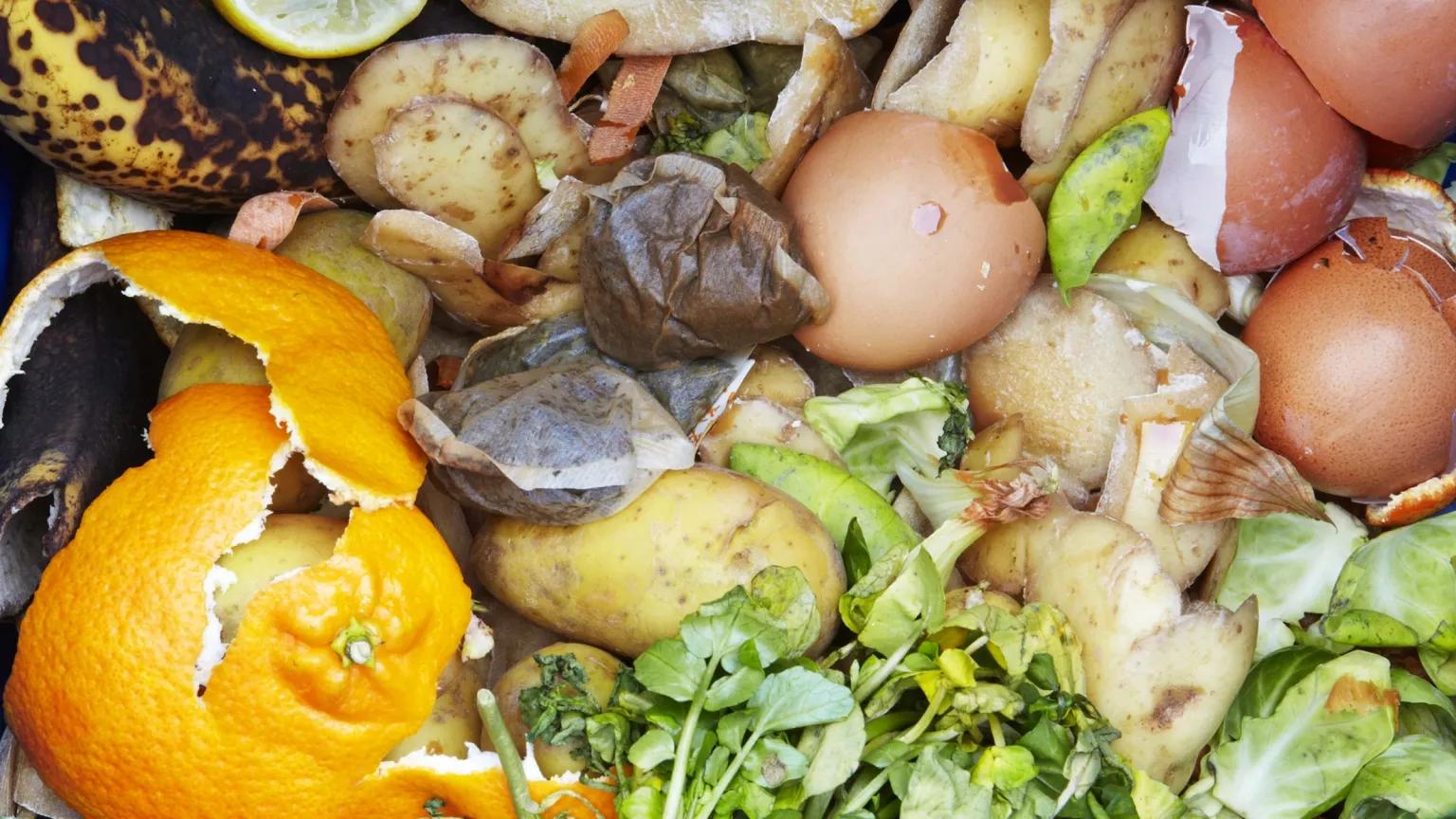
Masterfile
What is composting?
Composting is the natural process of recycling organic matter, such as leaves and food scraps, into a valuable fertilizer that can enrich soil and plants. Anything that grows decomposes eventually; composting simply speeds up the process by providing an ideal environment for bacteria, fungi, and other decomposing organisms (such as worms, sowbugs, and nematodes) to do their work. The resulting decomposed matter, which often ends up looking like fertile garden soil, is called compost. Fondly referred to by farmers as “black gold,” compost is rich in nutrients and can be used for gardening, horticulture, and agriculture.
Organic discards can be processed in industrial-scale composting facilities, in smaller-scale community composting systems, and in anaerobic digesters, among other options. This guide focuses primarily on home composting, which is a great way to keep your organic discards out of the waste stream and produce a valuable soil amendment for your own use.
Benefits of composting
Reduces the waste stream
Composting is a great way to recycle the organic waste we generate at home. Food scraps and garden waste combined make up more than 28 percent of what we throw away, according to the U.S. Environmental Protection Agency (EPA). Not only is food waste a significant burden on the environment, but processing it is costly. The average cost to landfill municipal solid waste in the United States was around $55 per ton in 2019. With the United States generating more than 267 million tons of municipal waste in 2017 and sending two-thirds of that to landfills and incinerators, we spent billions of dollars on waste management. Composting at home allows us to divert some of that waste from landfills and turn it into something practical for our yards.
Cuts methane emissions from landfills
Typically when organic matter decomposes, it undergoes aerobic decomposition, meaning that it’s broken down by microorganisms that require oxygen. When compostable waste goes to a landfill, it gets buried under massive amounts of other trash, cutting off a regular supply of oxygen for the decomposers. The waste then ends up undergoing anaerobic decomposition, being broken down by organisms that can live without free-flowing oxygen. During anaerobic decomposition, biogas is created as a by-product. This biogas is roughly 50 percent methane and 50 percent carbon dioxide, both of which are potent greenhouse gases, with methane being 28 to 36 times more effective than CO2 at trapping heat in the atmosphere over a century. Although most modern landfills have methane capture systems, these do not capture all of the gas; according to the EPA, landfills are the third-largest source of human-generated methane emissions in the United States.
Because our solid waste infrastructure was designed around landfilling, only about 6 percent of food waste gets composted. However, states, cities, and individual businesses and vendors can spearhead zero-waste strategies to increase composting and recycling rates within their jurisdictions and to keep waste from being generated in the first place. There have been many composting success stories around the country, one notable example being San Francisco. In 1996, San Francisco established a large-scale composting program, and by 2000 it was able to divert 50 percent of its waste from landfills. By increasing its goals over the years, San Francisco has been diverting more than 80 percent of waste from landfills since 2012. That means more than 90,000 metric tons of carbon emissions are avoided each year—equivalent to the annual greenhouse gas emissions from 20,000 passenger vehicles.
Improves soil health and lessens erosion
Compost is an essential tool for improving large-scale agricultural systems. Compost contains three primary nutrients needed by garden crops: nitrogen, phosphorus, and potassium. It also includes traces of other essential elements like calcium, magnesium, iron, and zinc. Instead of relying on synthetic fertilizers that contain harmful chemicals, composting offers an organic alternative. Research has shown the capability of compost to increase soil’s water retention capacity, productivity, and resiliency.
Conserves water
Agriculture is a major consumer of water in the United States, accounting for approximately 80 percent of the nation’s water use, according to the EPA. Irrigation systems are effective but are expensive and time-consuming for farmers to manage. Additionally, water is becoming increasingly difficult to obtain across the country.
How can compost help? Research has shown the water-retaining capacities of soil increase with the addition of organic matter. In fact, each 1 percent increase in soil organic matter helps soil hold 20,000 gallons more water per acre. By using compost to foster healthy soil, farmers do not have to use as much water and can still have higher yields compared with farming with degraded soil.
Reduces personal food waste
Consumers are responsible for a staggering amount of wasted food. An average American family of four throws out about $150 worth of food per month, a 50 percent increase since the 1970s. NRDC research in three U.S. cities indicated that the category of edible food most wasted by households was fruits and vegetables. According to a 2016 report in The Guardian, U.S. retailers and consumers throw away about 60 million tons (or $160 billion) worth of produce annually. The best way to reduce impacts from food waste is to prevent waste from occurring in the first place, so NRDC works through its Save the Food campaign and other tools to educate consumers on how to shop for, prepare, and store food to minimize waste. However, even if we do everything possible to decrease food waste, there will still be food scraps that cannot be consumed (e.g., a banana peel). Composting is a great way to recycle those discards instead of tossing them in the trash.
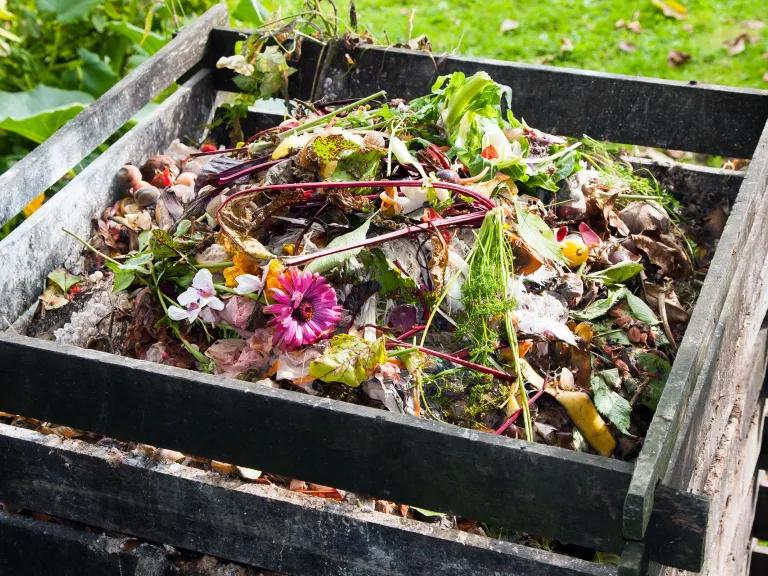
Piotr Malczyk/iStock
Types of home composting
Composting can be done both indoors and outdoors and can be as complicated or as simple as you would like. The best way for you to compost at home depends on several factors:
- Where you live/availability of space
- How much organic waste you produce
- What kind of organic waste you produce (kitchen and/or yard waste)
- Amount of time you can spend on the composting process
There are two main types of backyard composting: cold (also known as passive composting) and hot (also called active composting). Cold composting breaks down organic matter slowly, but it also takes the least amount of effort and maintenance. Anything organic decomposes eventually; cold composting is just letting Mother Nature do her job with minimal intervention on your part. You do not need to worry about the ratio of compost ingredients, aerate regularly, or monitor moisture levels. Cold composting is the best process if you have little organic waste to compost and not much time to tend to the process, and if you are not in a hurry for finished compost. However, depending on what kind of cold method you use, it can take one to two years before you get usable compost. Additionally, a cold composting process will most likely not reach a high enough temperature during decomposition to kill off pathogens, so depending on what you’ve put in the pile, there may be some lingering harmful pathogenic bacteria, fungi, protozoa, worms, and other parasites as well as weed seeds in your finished product. A cold composting process is primarily anaerobic, meaning that your discards are broken down by microorganisms that thrive in an oxygen-deprived environment. In addition to being slower to break down, cold piles may be smellier or wetter than hot piles.
Hot composting is a faster, but more managed, compost process. This method requires attention to keep carbon and nitrogen in the optimum ratio to decompose organic waste. It also requires the right balance of air and water to attract the organisms that thrive in an oxygen-rich environment. Under ideal conditions, you could have the final compost product in four weeks to 12 months. If managed correctly, the high temperature of the pile will destroy most weeds, plant diseases, pesticides, and herbicides, plus any bug larvae or eggs.
How to compost
Compost ingredients
Organisms that decompose organic waste need four key elements to thrive: nitrogen, carbon, air, and water. Since all compostable materials contain carbon, with varying amounts of nitrogen, composting successfully is just a matter of using the right combination of materials to achieve the best ratio of carbon to nitrogen and maintaining the right amounts of air and water to yield the best results. The ideal carbon-to-nitrogen ratio for a compost pile is 25 to 30 parts carbon for every 1 part nitrogen. If your pile has too much carbon-rich material, it will be drier and take longer to break down. Too much nitrogen-rich material can end up creating a slimy, wet, and smelly compost pile. Fortunately, these problems are easily remedied by adding carbon-rich or nitrogen-rich material as needed.
“Greens” for Nitrogen
Nitrogen is one of the basic building blocks of life, and it is an essential element for growth and reproduction in both plants and animals. A higher nitrogen-to-carbon ratio is most commonly found in fresh organic material (often referred to as greens). Having plenty of greens in your compost pile makes sure the decomposers can grow and reproduce quickly. Some household greens you can add to your home compost pile are fresh grass clippings, food scraps, and coffee grounds.
“Browns” for Carbon
Another essential compound for all life forms is carbon, higher proportions of which can be found in brown plant material. Carbon acts as a food source for decomposers, helping to keep them alive while they break down waste. Typical browns you can add to a compost pile include dead leaves, branches, twigs, and paper.
To achieve the best carbon-to-nitrogen ratio in your home compost, a rule of thumb is to put in two to four parts brown materials for every one part green materials.
Oxygen and Water
Finally, like any other living organism, decomposers need oxygen and water to survive. To ensure a faster home composting process, you will need to make sure your compost system has the right amount of air and water. As mentioned above, if you are not in a rush for finished compost, you do not have to maintain your waste; the decomposition will still take place, just at a much slower pace. Optimal air flow can be achieved by layering materials, making sure your materials are in small pieces (ideally no thicker than a finger), and turning piles regularly (or adding another type of aeration system). As for water, the ideally moist household compost pile will be about as wet as a wrung-out sponge. If you are including food waste in your pile, it’s likely it will be wet enough, but if not, just add water.
Temperature
Hot composting is achieved when the balance of greens, browns, air, and water creates ideal conditions for aerobic organisms to thrive. The optimal peak temperature for aerobic composting is 130 to 140 degrees Fahrenheit, which occurs when aerobic macro- and microorganisms are breaking down waste and reproducing at a fast rate. This high temperature also kills any lingering bacteria or weed seeds.
Consistent aeration
Aeration encourages an aerobic environment, which helps to speed up the composting process and reduce odors. It is recommended you turn your pile (or rotate your tumbler) around once a week during summer and at minimum once every three to four weeks during winter. You can also add piping or large sticks to help increase natural airflow.
Maintaining moisture
Moisture is essential for composting—your pile should always feel like a wrung-out sponge. Too dry a pile may cause the composting process to slow down. Too wet a pile may create an anaerobic environment, which can cause bad odors and also slow down decomposition. Water your pile (or add more wet materials) if it becomes too dry, and add carbon-heavy browns if it becomes too wet.
Size
A 3-foot cube is the ideal size for a compost bin or pile. You need a large volume of waste to be able to produce a high enough temperature for aerobic organisms to thrive. However, piles larger than 5 cubic feet are not likely to allow enough air to reach the decomposers at the center; they may also be harder to turn. Chop up larger pieces of food or yard scraps before adding to your bin or pile. The smaller the pieces, the quicker the decomposition process will be. A good rule is not to include anything thicker than a finger.
Location
The ideal compost location is a dry and shady spot. If you live in a rainy climate, avoid placing your pile or bin under eaves or places with poor drainage, or else the compost may get too soggy. If you live in a sunny environment, find a shady spot so it doesn’t dry up too quickly and you don’t have to keep adding water.
To start your pile, add alternating thin layers of greens and browns, ending with a layer of browns. (You can keep adding materials over time until you reach the optimal height of 3 feet.) Wet the compost pile if needed as you layer. Then leave the pile alone for four days to allow initial decomposition to begin, after which you can regularly aerate your pile or bin by turning with a pitchfork or garden fork and regularly monitor the moisture level.
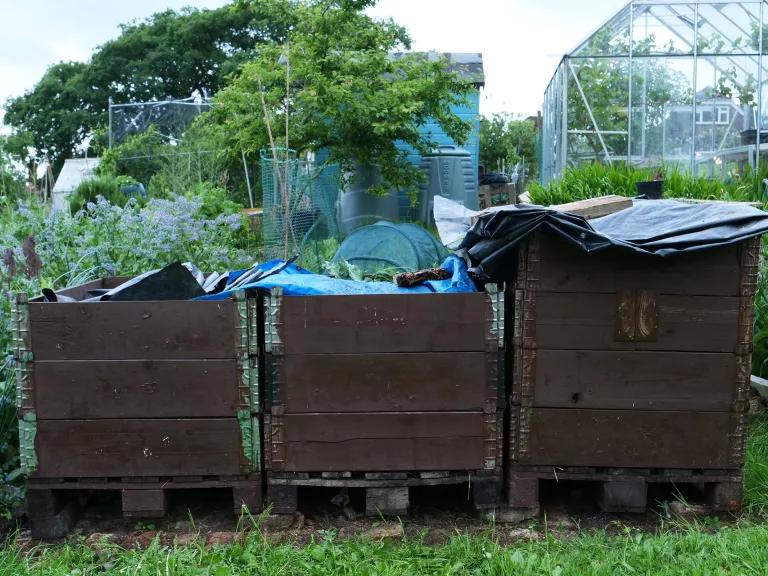
Joe / Alamy Stock Photo
Compost bin
Using a bin is the simplest and cheapest method for small-scale, at-home composting.
Closed Bin
A closed compost bin is an enclosed structure that keeps your composting materials together and helps to retain heat and moisture. Typically, closed bins have an open bottom and you place the bin directly on a patch of soil. The open bottom allows the nutrients in the developing compost to travel directly into the soil. You can either buy a compost bin or build one yourself, making sure to include a removable top so you can add more compostable materials as you accumulate them. Depending on the material you build your bin out of, you may have to drill or punch holes along the sides to allow airflow (or turn it manually for a hotter process). You should ensure that any holes or openings in the bin are small enough to prevent entry by rodents or any other animals of concern. You can build your bin to fit the amount of organics you expect to produce over time—size can range from 3 by 3 by 3 feet to a larger, three-bin system
You may already have some materials around the house to use for a DIY bin. Possibilities include:
- Wine crates
- Plastic storage bins
- Old wooden dresser drawers
- Garbage can
- Wire mesh
- Wood pallets
Open Bin
Open-topped bins (or open compost systems) typically require less maintenance and are better suited to composting yard waste (food waste may attract animals, and open bins are not animal proof). An open bin can be as simple as a loop of chicken wire that allows you to dump materials in. You can even just pile materials on the ground without an enclosure. With an open bin, you have easier access to the composting material. The primary disadvantage is that materials are loosely confined and may be easily accessed by animals or insects, or they may spill out over the boundaries of the bin or pile.
Open bins can be purchased, or you can make one yourself by driving metal stakes or wooden posts into the soil, ideally in a 3-by-3-foot square, and then wrapping the posts with wire mesh fencing. If you have the materials handy, you can also make an open bin from wooden pallets. You can use this method for either hot or cold composting, depending how much you’d like to monitor the balance of materials, turn the pile for aeration, and ensure the right moisture level.
Tumbler Bin
A tumbler is a sealed container that is mounted on an axle or base and can be rotated with a handle. By turning the container, you are aerating and mixing the waste inside, which will help foster aerobic conditions to break down the materials and speed up the composting process. A sealed drum tumbler retains moisture and heat (note that you may need to monitor moisture more carefully to ensure it doesn’t get too wet). An aerated tumbler with built-in air vents, on the other hand, speeds up the composting process. With ideal conditions, tumblers can convert waste to finished compost in as little as three weeks, though a month or two is much more common. Compost tumblers can be purchased online or in most gardening stores.
Trench composting
Another form of home composting involves burying your organic waste directly in the soil. Trench composting can help nearby plants develop water-conserving root systems. Moreover, it is odorless and invisible since all the waste is buried underground. Trench composting can be easier than maintaining a compost pile: All you have to do is dig a hole, fill it with organic waste, and cover it up with soil. Earthworms and other organisms in the soil do the rest of the work. You can trench compost any time of year as long as the soil in your yard remains pliable and manageable. However, this method is best suited to a single application of materials and is generally not practical if you want to compost materials on an ongoing basis, unless you have a lot of space and are willing to dig up your yard regularly.
One of the benefits of trenching is that it allows you to compost small amounts of cooked food waste, including meat, grains, and dairy, because animals and insects are less likely to be attracted to the material if it is buried deep underground. If you do decide to compost animal products, be sure to cover them with 12 to 18 inches of soil.
To start a simple compost pit, use a shovel to dig an elongated hole 12 to 24 inches deep. Fill in the pit with your organic waste, making sure the items are quite moist, and then fill the hole back up with soil. One of the downsides to this method, as with all cold composting methods, is that it takes longer for the waste to decompose. Trenching can produce finished compost in about 12 months, sometimes sooner if the conditions are ideal. Note that you will not be able to harvest the finished compost, so it is best to dig your trench wherever you’d like the nutrients to end up.
If you do not have much organic waste or enough space in your yard for a trench, you can also use the “dig and drop” method, which involves digging out small, 12- to 18-inch holes in the ground and burying the waste in them. You can dig and bury as you accumulate your waste and place small markers on top of the holes as you go so you don’t dig in the same spot twice.
Tips for Trench Composting
- Don’t dig near existing root systems so as not to harm or introduce bacteria to those plants.
- Don’t plant anything directly on top of your trench as the soil will sink during the composting process.
- If you live in an arid area, water the soil on top of the trench to maintain moisture.
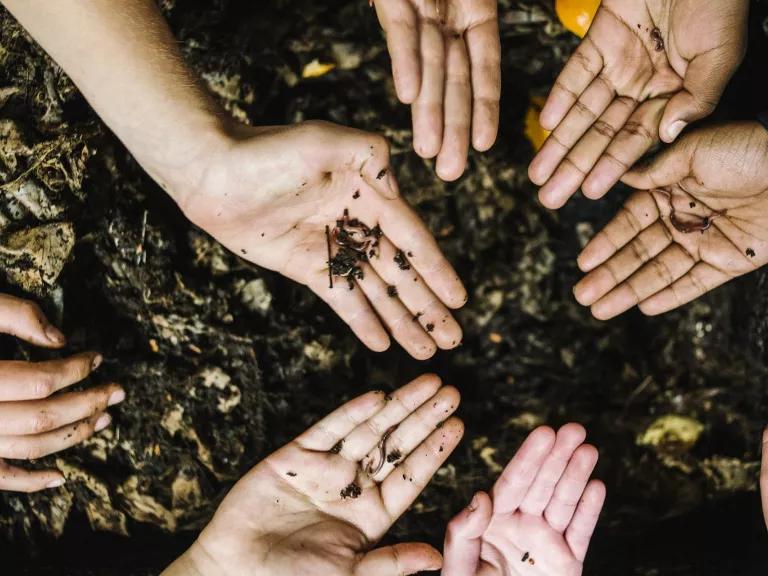
Matt Nager for NRDC
Vermicomposting
Vermicomposting, or worm composting, is a great indoor option if your outdoor space is limited (it can be done outdoors as well). You can do it year-round in a basement or garage or even under your sink. Vermicomposting produces natural, odorless castings, which are a nutrient-rich fertilizer, in about three to six months. There is very little maintenance required; the most significant time commitment is harvesting the vermicompost every few months.
You can purchase a cheap worm composter in stores or make one yourself. At its simplest, a vermicompost system can be a wooden or plastic bin with holes in the sides and bottom for ventilation and drainage (similar to a regular enclosed compost bin). A worm composter needs to be raised off the ground to allow excess liquids to flow out. A simple setup for worm composting is to place a taller plastic bin inside a shorter one. Then you have to add worm bedding and some soil. Bedding should be made out of carbon-heavy material to help hold the right amount of air and moisture for the worms. Some common materials for bedding are:
- Shredded paper
- Shredded cardboard
- Dry leaves
- Straw
Feed the worms once a week by burying your food waste under their bedding. Ideal food for the worms includes fruit and vegetable scraps, bread and grains, coffee grounds and used tea leaves. Don’t feed them any animal products or fats and oils, or anything too thick (like a watermelon rind or corncob). The moisture level of the bedding should be similar to that of a damp sponge, so make sure you check on that regularly as well.
The best types of worms to use for vermicomposting are red wigglers, a species that is very easy to maintain and actually prefers the compost environment over regular soil. Red wigglers can eat half their body weight in a day. A typical home system needs about a pound of worms. Check out this video to see how much one pound of worms looks like so you can ensure that you buy the right quantity for your bin.
Tips for Vermicomposting
- Avoid using a metal bin as this can cause the inside to be uncomfortably hot or cold for the worms. Worms tend to thrive in temperatures ranging from 55 to 77 degrees Fahrenheit.
- Keeping your worm bin indoors is ideal for many locations; you do not want your worms to freeze in the winter or get too warm in the summer.
- Give the worms a day or two to adjust to their new environment and ease into the feeding to figure out the best amount of waste to give them. If you add too many food scraps, the worms may not be able to consume it all before the food rots and attracts insects.
- Your worms should be fed about once per week. If you are going to be away from home for longer than that, remember to get a worm sitter so your worms don’t die.
What can you compost?
Anything that comes from the ground can be composted at home. While animal products can often be composted in municipal composting systems, at-home composting should avoid those items as they can attract animals and insects and leave pathogens in the final product.
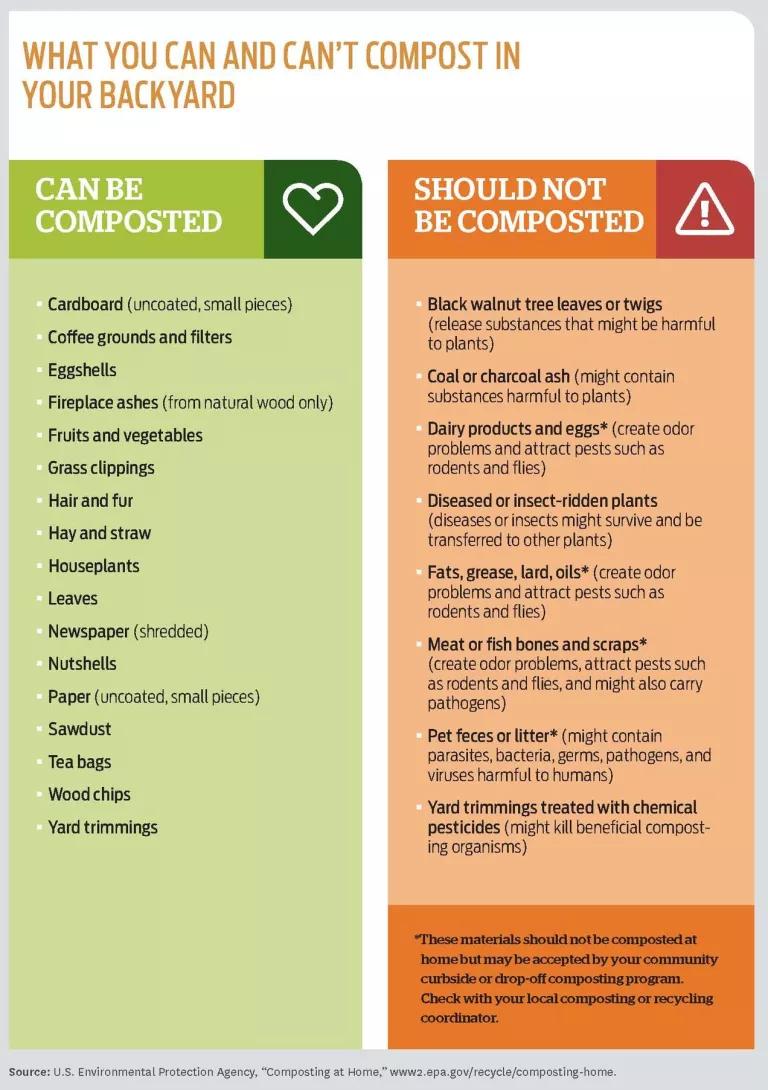
From "Waste-Free Kitchen Handbook" by Dana Gunders
What not to compost
Pet waste
Pet waste contains parasites and bacteria that can be harmful to humans and other animals if ingested. These pathogens can find their way into your body if you use compost that contains pet waste as fertilizer on edible crops. Compost must reach and remain at a minimum of 131 degrees Fahrenheit for three consecutive days to kill pathogens found in pet waste, and it is hard to regulate and monitor that if you are composting at home. It may be possible to compost dog waste in a home system, but you must follow USDA guidance carefully to ensure the proper conditions, and you should not include cat or any other pet waste. The USDA has resources that provide step-by-step instructions on how to compost dog waste, along with some recommendations to decrease health risks, including:
- Confining the compost pile to a specific area in your yard
- Not feeding dogs raw meat or fish and not including waste from unknown dogs
- Not applying dog waste compost to crops you intend to ingest
- Keeping children away from the compost pile
Inorganic materials, such as plastic
Colored or glossy paper
Specialized color or glossy paper may contain toxic materials from the printing inks and additives that may be harmful to humans, animals, and plant life.
Diseased plants
If your pile doesn’t reach a high enough temperature, plant diseases might survive and be spread to other plants when you use the compost.
Dairy and other animal products
While animal products (meat, fish, eggs, bones, dairy, grease, fat) are organic, they can create odor problems and attract flies, rodents, and other pests to your pile or bin. These products can also carry pathogens that may survive the home composting process. You can trench compost small amounts of animal products.
These materials should be kept away from at-home compost collections. However, if you have a large amount of these materials, see if your municipality accepts food waste for composting, or reach out to a nearby composting program that may accept these items. Large-scale composting facilities can often take in these materials and compost them without the risks faced by a home composter.
More tips for composting at home
Preventing or getting rid of fruit flies in your compost bin
It is important to note that while fruit flies are annoying, they are harmless to humans and to compost. However, they reproduce quickly and can infest your yard or kitchen if not addressed. Here are some things you can do:
- Increase the carbon-rich browns in your compost pile to help the organic waste dry out. Fruit flies are primarily attracted to greens and will be less likely to linger if you dig a hole in your compost pile and bury greens under a layer of browns.
- Buy or make a fruit fly trap. (Note: Use these traps indoors only, as other critters can easily get trapped if you use them outside.)
- Boil your food waste before adding it to your pile to make it less enticing to fruit flies.
- Don’t add new materials to your pile for a few days to force the fruit flies to go elsewhere for food.
- Purchase a compost keeper to collect food scraps in your kitchen, and add to your pile when it’s full (or once a week or so). There are compost keepers that come with a charcoal filter to help absorb odors.
Safety precautions
Take standard safety precautions when handling the waste (e.g., washing your hands afterward, avoiding touching your face). If you have a condition that predisposes you to an allergic reaction or infection, wear a dust mask while tending to your pile, especially in dry weather.
How to use compost
Compost needs to entirely stabilize and mature before it can be used. Not only can immature compost damage your plants, but it can also attract rodents and other pests to your yard. You will need to stop adding material in order for your pile to mature (although in no-turn systems, the bottom of the pile may provide finished compost even if the top of the pile is still active). You can identify finished compost by looking for these characteristics:
- Texture: Crumbly and smooth, without recognizable scraps.
- Smell: Like a forest on a rainy day, or rich earth. Traces of ammonia or sour odors means the compost needs more time to mature.
- Color: Dark and rich
- Size: One-third the original size of your pile
- Temperature: Within 10 degrees Fahrenheit of the temperature outside (especially in the middle of the pile)
Once you have confirmed that your compost is mature, here are some ways you can put it to use:
- Use it as mulch
- Add it to potting soil
- Work it into crop beds
- Distribute it on lawns
- Mix it into garden beds
- Feed it to potted plants
- Add it to soil around fruit trees
Compost cannot go bad, but it can get too wet, too dry, or too old. You can still use compost that is old; it just might not have as many nutrients in it as fresh compost.
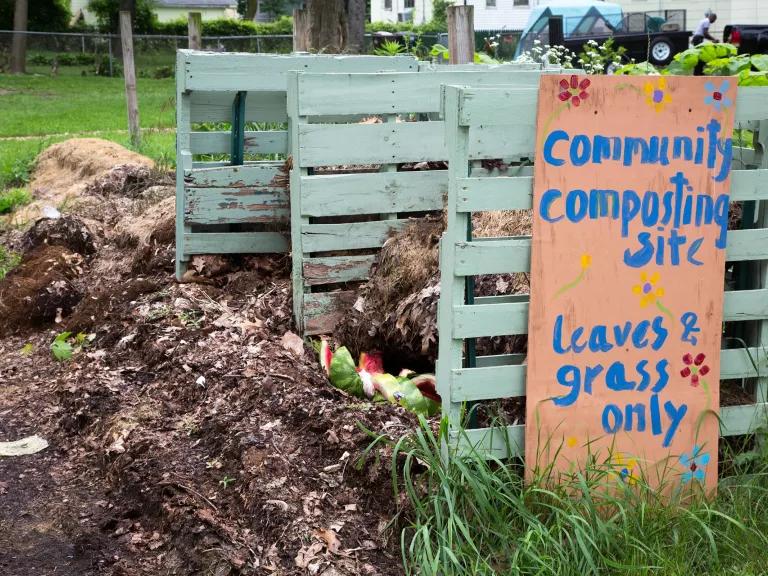
Jim West / Alamy
Community composting
Don’t want to DIY? Outsource your composting
If you don’t want to compost yourself or can’t compost in your home, you can still collect organic waste and get it to a composter. Some cities have programs that provide curbside collection of organic waste along with regular trash on select days. Check your local municipal website or call 311 to see if your city has such a program. Or find a nearby community or municipal composting site where you can subscribe to a pickup service or drop off your organic waste. If your city doesn’t have a composting program, help jump-start interest by lobbying city council members, or start a community composting project yourself. If you outsource your composting, use a compost keeper to store food scraps between pickups or drop-offs. During summertime, you can also freeze your food scraps before taking them to your compost site to reduce the chance of foul odors or maggots.
Composting is not an exact science. It takes time and experience to figure out the best way for you to compost in your environment. Because it is a biological process, results may vary each time you try it, even if you don’t change your method at all. Don’t be afraid to tinker around with your bins, your ratio of browns to greens, or how often you aerate or water your pile. Remember—rot happens! Your compost pile will break down eventually no matter what. The more time you spend with it, the more you will learn.
This NRDC.org story is available for online republication by news media outlets or nonprofits under these conditions: The writer(s) must be credited with a byline; you must note prominently that the story was originally published by NRDC.org and link to the original; the story cannot be edited (beyond simple things such as grammar); you can’t resell the story in any form or grant republishing rights to other outlets; you can’t republish our material wholesale or automatically—you need to select stories individually; you can’t republish the photos or graphics on our site without specific permission; you should drop us a note to let us know when you’ve used one of our stories.

Food Waste 101
In Planning for Climate Change, Native Americans Draw on the Past
The Smart Seafood and Sustainable Fish Buying Guide